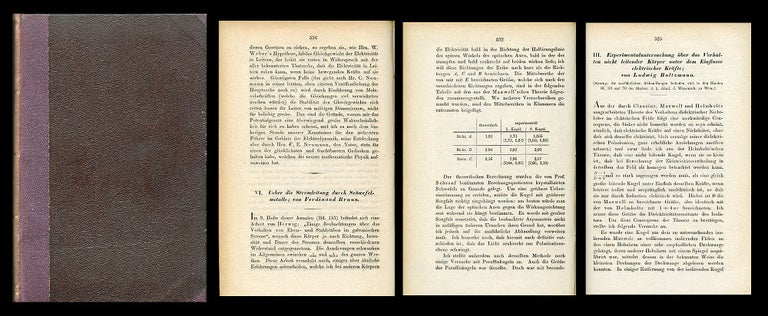Uber die Stromleitung WITH Experimentaluntersuchung über das Verhalten nicht leitender Körperunter dem Einfluss elektrischer Kräfte Annalen der Physik and Chemie, Vol. 153, No. 4, 1874, pp. 556-563 (Braun); pp. 525-534 (Boltzmann)
Leipzig: Johann Ambrosius Barth, 1874. 1st Edition. FIRST EDITION, BOUND FULL VOLUME, OF THE FIRST WRITTEN DESCRIPTION OF A SEMICONDUCTOR DEVICE, A DIODE RECTIFIER; Braun’s discovery of the semiconductor point-conduct rectifier effect. In this 1874 paper, “Braun observed that an electric current flows freely in only one direction at the contact between a metal point and a galena (lead sulfide) crystal. He later went on to use this device as an early ‘crystal radio’ receiver (History of Physics: The Wenner Collection). Information on the Boltzmann paper appears at the end.
“A semiconductor is a material that behaves like both a conductor and an insulator. The electrical conductivity of a semiconductor can be modified by adding small quantities of other elements (called “doping”), leading to an array of electrical characteristics that have made possible the development of modern electronics” (Wenner).
“German physicist Ferdinand Braun, a 24-year old graduate of the University of Berlin, studied the characteristics of electrolytes and crystals that conduct electricity at Würzburg University in 1874. When he probed a galena crystal (lead sulfide) with the point of a thin metal wire, Braun noted that current flowed freely in one direction only. He had discovered the rectification effect at the point of contact between metals and certain crystal materials” (Computer History Portal). In 1874 and in this paper, Braun published the results of his research. “He found that these crystals [mineral metal sulfides] conducted electric currents in only one direction. This information was important in electrical research and in measuring another property of substances, the electrical conductivity, but Braun’s discovery did not have immediate practical application. In the early twentieth century the principle that Braun had discovered was employed in crystal radio receivers” (Dictionary of Scientific Biography).
“The Nobel Prize in Physics 1909 was awarded jointly to Guglielmo Marconi and Karl Ferdinand Braun "in recognition of their contributions to the development of wireless telegraphy” (Nobel Prize Committee).
ALSO INCLUDED: An important theoretical contribution to the subject of rheology, the branch of physics that deals with the deformation and flow of matter, especially the non-Newtonian flow of liquids and the plastic flow of solids. This is Boltzmann’s first rheological paper, the others published in 1877 and 1878. All “had a significant impact on the mathematical theory of viscoelasticity”, and this work in particular was “an important and influential work of generalization (which can incorporate both solid-like and liquid-like responses). [In this paper Boltzmann], introduced an integral constitutive equation which generalized all previous work on non-classical materials” (Gallegos, Rheology, 19). Following the views Boltzmann puts forth in this paper, “the mathematical analysis of a specific problem is based on and justified by the experimental analysis; calculations must be developed up to the point of ‘making possible an immediate comparison with the experiment’” (Ianniello, Boltzmann and Hereditary Mechanics, 4). Ludwig Boltzmann was an Austrian physicist and philosopher whose most important work was done in statistical mechanics. Item #840
CONDITION & DETAILS: Leipzig: Johann Ambrosius Barth, 1857. Octavo (8.25 x 5.5 inches; 206 x 138mm). Full volume. Old handwritten paper label at the spine, no other marks save for the prior owner’s name on front free endpaper. 4 fold-out plates and illustrated throughout. Tightly and solidly bound in contemporary cloth and buckram, minor scuffing at the edges. Evenly toned and clean throughout. Very good + condition.
Price: $300.00

